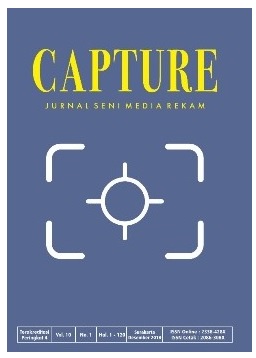RESTRAINING THE MOOD FOR LOVE: A SEMIOTIC ANALYSIS OF WONG KAR WAI’S IN THE MOOD FOR LOVE
DOI:
https://doi.org/10.33153/capture.v12i1.3086Keywords:
Visual signs, symbol, index, icon, restraintAbstract
This article attempts to explore the visual signs in Wong Kar Wai’s In the Mood for Love in the context of how they support and emphasize the topic of restraint through the film’s cinematography and misè-en-scèene. As the theoretical foundation, Peirce’s classification of signs into symbol, icon, and index is chosen in addition to Barthes’ five systems of meanings that are applied to cinema. The visual signs in focus are not limited to objects within the film, but also the characters’ actions as well as the cinematography. The findings show that certain signs are effectively displayed to signify and amplify the idea of restraint. Not only that, some signs evolve into different signs through intentional repetition to further emphasize the aforementioned idea and the arbitrary nature of the signs, and at the same time open the possibilities of different interpretations of the signs within the film.
Downloads
References
Brindle, L. (2019, Sep 2). A Deeper Understanding: In the Mood for Love and Yumeji’s Theme. Take One Magazine: Bringing the Best of Arthouse and Festival Cinema into Focus. http://takeonecinema.net/2019/a-deeper-understanding-in-the-mood-for-love-and-yumejis-theme/
Carvalho, L.M.M.d. (2009). The Ambivalent Identity of Wong Kar Wai’s Cinema (Publication No. 3244) [Doctoral Dissertation, Université de Montréal]. Papyrus: Institutional Repository.
Chan, A. (2016, Aug 24). BBC Names ‘In the Mood for Love’ 2nd Best Film of the Century. Coconuts Hong Kong. https://coconuts.co/hongkong/lifestyle/bbc-names-mood-love-2nd-best-film-century/
Chandler, D. (2019, Aug 1). Semiotics for Beginners. cs.princeton.edu. https://www.cs.princeton.edu/~chazelle/courses/BIB/semio2.htm
Front, S. (2011). Laybyrinth of Time in Wong Kar Wai’s In the Mood for Love and 2046. Researchgate. https://www.researchgate.net/publication/303843741_Labyrinth_of_Time_in_Wong_Kar-Wai%27s_In_the_Mood_for_Love_and_2046?enrichId=rgreq-54b63b5fa1cc35fcb33e786d241e3bf9-XXX&enrichSource=Y292ZXJQYWdlOzMwMzg0Mzc0MTtBUzo3MTc5Mjk5Njg1Nzg1NjNAMTU0ODE3OTI1MTk4NQ%3D%3D&el=1_x_2&_esc=publicationCoverPdf
In the Mood for Love (2000). [Film]. Wong Kar Wai (Dir.). Paradis Films.
Jayadev, L. & Aich, S.C. (2019). Wong Kar Wai’s Technique of Communicating Emotions through Frames, Mise-en-scène and Soundtrack in In the Mood for Love. International Journal of Innovative Technology and Exploring Engineering, 8(11), 2950-2954. DOI:10.35940/ijitee.K2258.0981119
Kuhn, A. & Westwell, G. (2012). A Dictionary of Film Studies. OUP Oxford.
Liu, H. (2009). The Cheongsam—The Treasure of Chinese National Apparel. Asian Culture and History, 1(1), 55-57. DOI:10.5539/ach.v1n1p55
Liu, Z. (2018). The Cultural Meaning and Aesthetic Implication of Chinese Cheongsam. Advances in Social Sciences, Education and Humanities Research, 232, 326-330.
https://doi.org/10.2991/icadce-18.2018.69
Rihane, W.M. (n.d.). The Cinematographical Love Affair. Academia. https://www.academia.edu/7770269/The_Cinematographical_Love_Affair_in_In_The_Mood_For_Love
“Restraint,” (2020). In lexico.com. Retrieved January 13, 2020, from https://www.lexico.com/definition/restraint
Sara, M. (2015, Feb). In the Mood for Love: Sebuah Kajian Semiotik. Universitas Indonesia Library. http://lib.ui.ac.id/file?file=digital/2016-3/20404801-MK-Mia%20Sara.pdf
Vilaro, A. & Orero, P. (2013). Leitmotif in Audio Description: Anchoring Information of Optimise Retrieval. International Journal of Humanities and Social Science, 3(5), 56-64.
Downloads
Published
Issue
Section
License
Copyright (c) 2020 Anton Sutandio

This work is licensed under a Creative Commons Attribution-ShareAlike 4.0 International License.
Copyright
Authors who publish with Capture: Jurnal Seni Media Rekam agree to the following terms:
- Authors retain copyright and grant the journal right of first publication with the work simultaneously licensed under a Creative Commons Attribution License (CC BY-SA 4.0) that allows others to share the work with an acknowledgment of the work's authorship and initial publication in this journal.
- Authors are able to enter into separate, additional contractual arrangements for the non-exclusive distribution of the journal's published version of the work (e.g., post it to an institutional repository or publish it in a book), with an acknowledgment of its initial publication in this journal.







